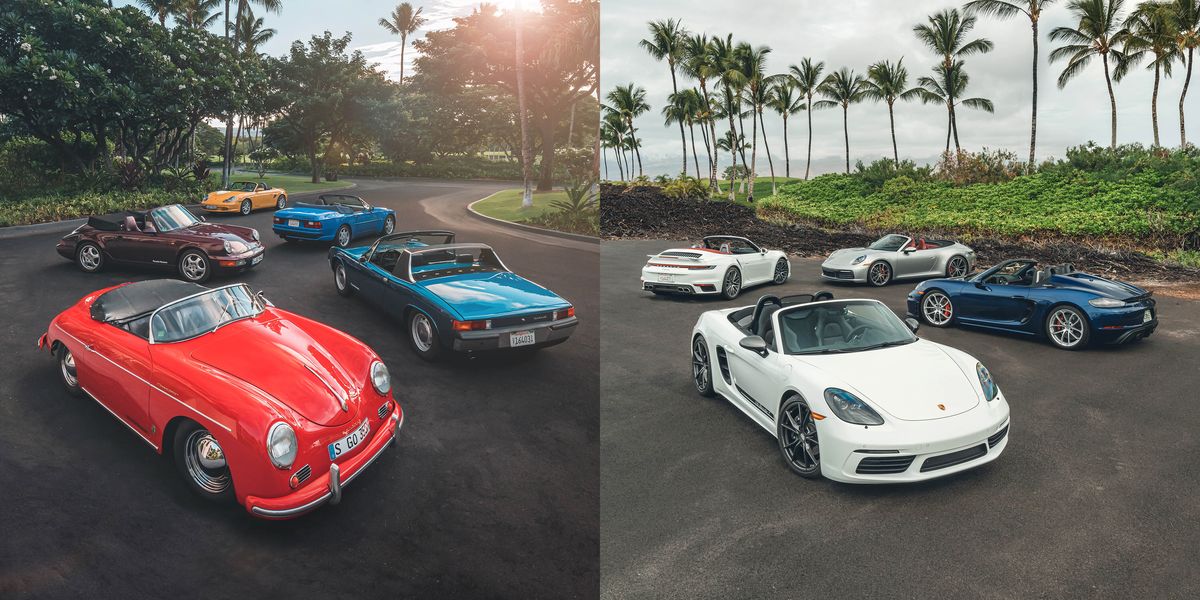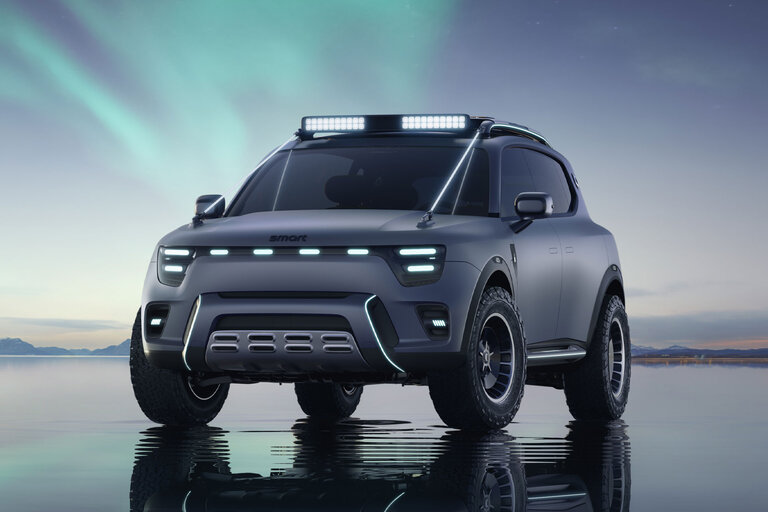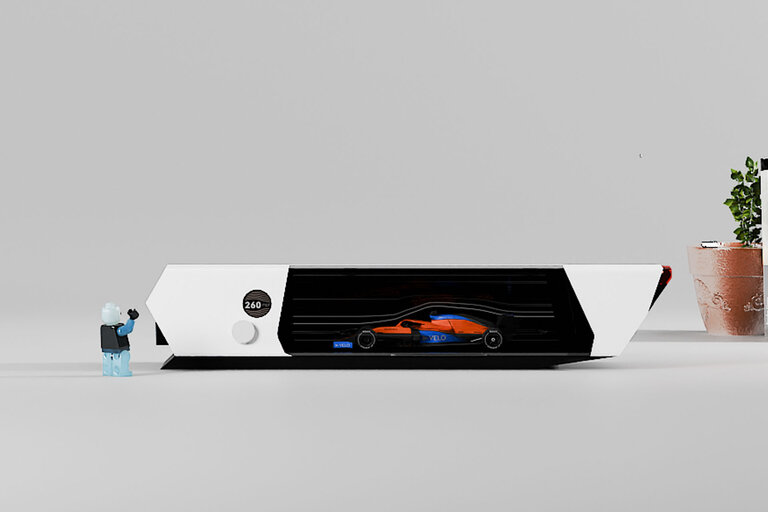
In Hawaii, there’s a tradition of storytelling through chanting and song. A historical record entirely told through song resonated as we drove some of the Porsche museum’s cars and new Porsches on Hawaii’s big island, Kona. Driving cars separated by decades can leave you struggling to find connection especially if you start judging with a vehicle-dynamics lens, but if you listen closely there’s a definite commonality between Porsches old and new.
356 Speedster and Boxster T
As the oldest vehicle sent by the museum, the 1957 356 Speedster has the longest amount of time between the modern Porsche, a new Boxster T, paired with it. Remarkably solid and graced with a supple ride, the Speedster is tiny. A Mazda Miata would tower over it, and there’s a slight safety concern since there aren’t any seatbelts. Rolling on tiny tires, the Speedster doesn’t have much grip, but with so little mass to keep in check, the Speedster is a delight. It reminds us that there are happy cars out there, cars that seemingly smile as they struggle to reach a 55-mph speed limit. A period-correct Nardi steering wheel, which replaces the three-spoke unit that the Speedster left the factory with, feels good and revectors the car with surprising precision. The gearbox slinks into and out of gear without any fuss. What truly dates the Speedster are its four drum brakes. Like many old cars, planning your moves in traffic is necessary to avoid scaring yourself or worse, damaging a car worth some $500,000.
Acceleration is lethargic, but occasionally you’ll peer down at the speedometer—the tachometer is rightly placed in the middle of the cluster—to see that the little 1.6-liter four has called up an extra-legal speed. Even when revved to its 5800-rpm redline, the engine isn’t loud. It waffles contentedly behind you gathering speed and emitting an occasional pop if you release the gas pedal quickly.
Equipped with a turbocharged 2.5-liter flat-four, the Boxster T is about as basic as you can spec a Boxster. Like the Speedster, it’s intended to appeal to the driver who just wants the options that make the car drive and handle better. It takes one corner to realize the technological leaps that have occurred since the Speedster. Against the Speedster, going fast in the Boxster is easy and doesn’t require much bravery or skill. Point it and it goes, toe the brakes and it’ll dislodge your sunglasses.
Put the top down—it’s a one-button affair compared to the two-person job required of the Speedster—and the Boxster’s flat-four barks out a similar tone, although the new car is louder. That there’s any connection at all is remarkable, but thanks to the inherent sounds created by a flat-four, it’s there and audible.
Porsche 914/6 and 718 Spyder
The next classic Porsche in the rotation is the 914/6. Porsche’s 914, a co-development with Volkswagen, is a mid-engine two-seater that much like the Boxster, was the entry-level Porsche sports car of its day. Sold from 1970 until 1975, most were powered by a breathed-on VW flat-four engine. A few, like this Adriatic Blue 914/6 from 1970, came with the 911 T’s 2.0-liter flat-six bolted in behind the driver. The 110-horsepower six sounds every bit like the angry little engine that it is, but acceleration is leisurely, primarily because of the wide gap between first and second gears.
It’s a challenge to find the gears at all given that the four-speed’s linkage does a Rube Goldberg-machine-like trip from the shifter to the 901 transmission (borrowed from the 911) that lives behind the engine. It takes a while to become even remotely proficient, and even then, it’s hard to imagine rowing it with anything resembling urgency. Despite the gearbox, the car charms with its simple design and impossibly low seating position. This example started its life in the United States before Porsche brought it home to Germany and took off the reflectors and bumper overriders of the U.S. models. The steering is slow and unassisted, but there’s reliable feel coming through. There’s also a notable amount of body roll. A price tag that butted up against a base 911 killed the 914/6’s chances in the market, but that lack of sales success makes it rare and therefore valuable today.
The current equivalent of the six-cylinder 914—at least according to the Porsche Museum—is the 718 Boxster Spyder. The Spyder comes with a high-revving naturally aspirated 414-hp 4.0-liter flat-six that sounds even angrier than the little six in the 914/6. The roadholding, brakes, and capability of the modern Porsche make the vintage car feel old, but rev either engine right into the redline, and the eagerness shines through. Just remember you may have to search for the next gear in the 914/6’s gearbox.
1991 Porsche 944 Turbo Cabriolet and 911 Turbo Cabriolet
The trip through Porsche history continues with the 944 Turbo cabriolet. Never sold in the United States, the 1991 convertible Turbo was a one-year sendoff launched the year before the 968 arrived. A mere 528 were produced, and this Maritime Blue example still looks captivating on its D90 16-inch wheels and with its pop-up headlights raised or lowered. The 2.5-liter turbo-four makes 247 horsepower, and that likely seemed quick back then. A period test of this engine in the coupe resulted in a zero-to-60 time of 5.6 seconds. Turbo lag means waiting for the revs to rise over 3000 rpm before meaningful oomph arrives. Once up to speed, the engine is happy to add more and more speed and it never really complains as it revs. Equipped with a balance shaft, the engine note is subdued and distant. It’s almost as if the engineering goal was silence.
Even with the top down, the cabriolet remains hushed. A rubbery shifter that doesn’t like being rushed connects to the transaxle in back. The seats are straight out of the 911, although the seating position takes some getting used to since the steering wheel isn’t adjustable and seems a bit too far away. As the top-performing 944 model, the Turbo has a firm suspension that isn’t as harsh as today’s sports cars, but it will send quivers through the structure. Modern convertibles are far stiffer—all those claims of improved torsional rigidity have apparently added up over the years.
The modern car that Porsche put up next to the 944 Turbo is the structurally stiff and seriously quick 911 Turbo cabriolet. Its 572-hp turbocharged flat-six churns through an all-wheel-drive system. While we haven’t tested a convertible 911 Turbo, we have tested the 640-hp Turbo S convertible, and it shot to 60 mph in 2.3 seconds—the lesser version might be a couple of tenths slower to that benchmark. The power of the 911 Turbo is shocking and the connection between past and present is probably the most tenuous in this matchup. They both have turbos—that’s the ticket.
1991 Porsche 911 Carrera 2 Cabriolet and 911 Carrera S
Among Porsche 911 collectors, the 964-generation 911—the penultimate air-cooled 911 and the first one with coil springs—is very hot right now. In the eyes of buyers, the convertible 911 ranks below the coupe and the Targa, and for many, the four-speed automatic in the Amethyst Metallic 911 Carrera 2 ragtop that the museum brought to Hawaii would be a deal-breaker. After driving it, we’re here to suggest reconsidering that thinking.
When the four-speed automatic arrived in the 911, we tested a coupe and found that it added more than a second to the 0-to-60 time. It might not be as quick as the five-speed version, but a coupe with the Tiptronic automatic still hit 60 in 6.1 seconds in our testing. From behind the wheel, that level of acceleration still feels fleet. Plus, with fewer gears and large gaps between the ratios, the sweet-sounding 247-hp flat-six is forced to stay in gears longer and work a bit harder. Drop the top and the six sings its gravelly song mostly through its intake, the exhaust is relatively subdued.
The Tiptronic automatic gave the driver the ability to select gears by moving the shifter over into the gate next to the PRND selector. Tip forward for an upshift and tip the stick back for a downshift. Steering-wheel paddles were still a few years away in 1991 but would arrive with the Tiptronic-equipped 1996 (993-generation) 911.
The transmission has no effect on the way this 911 goes down the road. A comfortable ride is perhaps the biggest surprise. The switch to coil springs and Porsche Classic dampers fitted by the museum provide a suppleness that seems so right for this Mercedes-Benz 500SL competitor. A tight structure belies this car’s age. There’s no cowl shake or bad vibes running through. Of all the vintage vehicles that were flown to Hawaii from Germany, the ’91 Cabriolet is the most relaxing and most rewarding. Buy one now before people catch on to the mellow genius of this 911.
Drive the 1991 911 and then step into the new 911 Carrera S Cabriolet, and there’s a familial connection, albeit a loose one separated by 30 years. The five round gauges in front of the driver in the air-cooled car are still honored, but four of the gauges are LCD displays. The tachometer remains analog and sits front and center, and the ignition is still on the left. The solidity of the chassis and the engine sound connect the old and new, too. Tight and quiver-free, the new 911 makes you forget that the top has been removed from the structure. And despite two turbochargers muffling the 443-hp 3.0-liter flat-six, that old familiar sound comes ringing through. Porsche history, told through sound.
#Making #Connections #Porsches #Porsches
Source link








